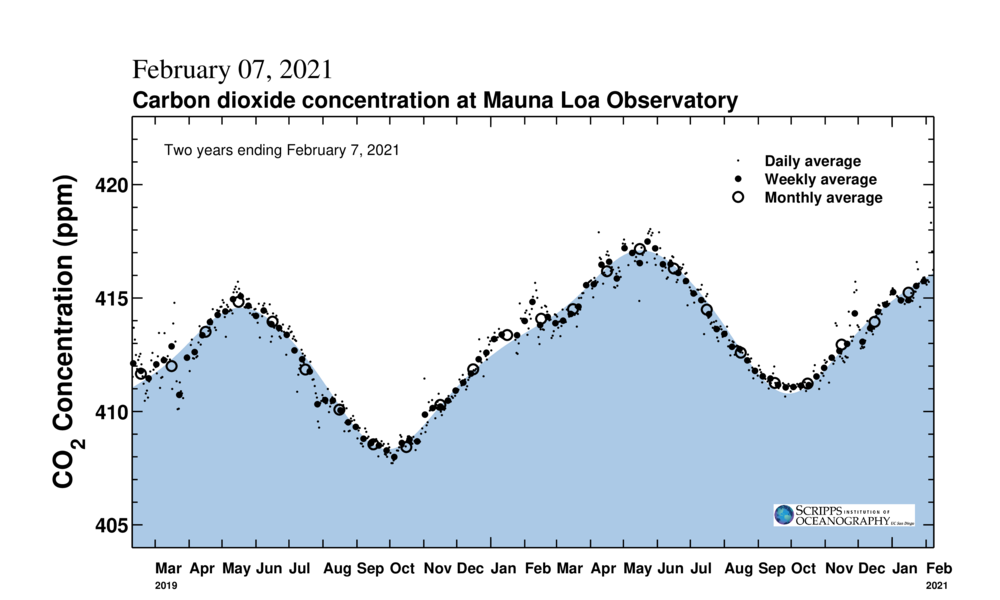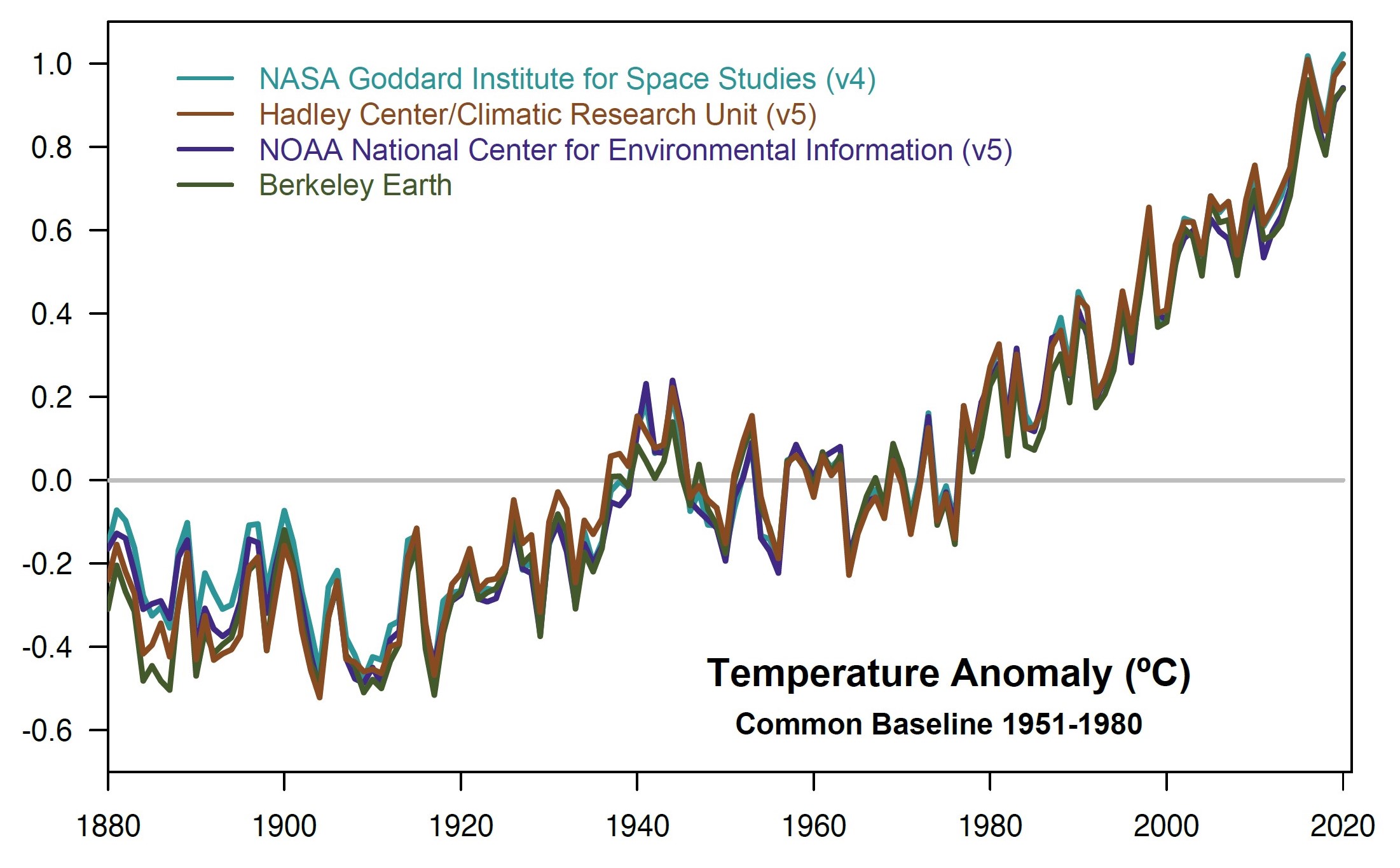CLIMATE SCIENCE: Breaking
— STACK ARCHIVE —
NEW STUDY: Current Atlantic Meridional Overturning Circulation weakest in last millennium
L. Caesar, et. al, Nature Geoscience, February, 2021
— Read about the science in the Washington Post —
QUOTE: The Atlantic Meridional Overturning Circulation (AMOC)—one of Earth’s major ocean circulation systems—redistributes heat on our planet and has a major impact on climate. Here, we compare a variety of published proxy records to reconstruct the evolution of the AMOC since about AD 400. A fairly consistent picture of the AMOC emerges: after a long and relatively stable period, there was an initial weakening starting in the nineteenth century, followed by a second, more rapid, decline in the mid-twentieth century, leading to the weakest state of the AMOC occurring in recent decades.
416.24 PPM
LATEST CO2 READING — Scripps Institute of Oceanography, UC San Diego.

>>> Learn more about the Keeling Curve
— scroll down to find the Keeling Curve animation video —
REPORT: Top 10 Insights in Climate Science in 2020
selected by 57 leading global researchers
by Future Earth, January 27, 2021
- Improved understanding of Earth’s sensitivity to carbon dioxide strengthens support for ambitious emission cuts to meet Paris Agreement: The climate’s sensitivity to carbon dioxide – how much the temperature rises with a certain increase of emissions – is now better understood. This new knowledge indicates that moderate emission reductions are less likely to meet the Paris climate targets than previously anticipated.
- Emissions from thawing permafrost likely to be worse than expected: Emissions of greenhouse gases from permafrost will be larger than earlier projections because of abrupt thaw processes, which are not yet included in global climate models.
- Tropical forests may have reached peak uptake of carbon: Land ecosystems currently draw down 30% of human CO2 emissions due to a CO2 fertilization effect on plants. Deforestation of the world’s tropical forests are causing these to level off as a carbon sink.
- Climate change will severely exacerbate the water crisis: New empirical studies show that climate change is already causing extreme precipitation events (floods and droughts), and these extreme settings in turn lead to water crises. The impact of these water crises is highly unequal, which is caused by and exacerbates gender, income, and sociopolitical inequality.
- Climate change can profoundly affect our mental health: Cascading and compounding risks are contributing to anxiety and distress. The promotion and conservation of blue and green space within urban planning policies as well as the protection of ecosystems and biodiversity in natural environments have health co-benefits and provide resilience.
- Governments are not seizing the opportunity for a green recovery from COVID-19: Governments all over the world are mobilizing more than US$12 trillion for COVID-19 pandemic recovery. As a comparison, annual investments needed for a Paris-compatible emissions pathway are estimated to be US$1.4 trillion.
- COVID-19 and climate change demonstrates the need for a new social contract: The pandemic has spotlighted inadequacies of both governments and international institutions to cope with transboundary risks.
- Economic stimulus focused primarily on growth would jeopardize the Paris Agreement: A COVID-19 recovery strategy based on growth first and sustainability second is likely to fail the Paris Agreement.
- Electrification in cities pivotal for just sustainability transitions: Urban electrification can be understood as a sustainable way to reduce poverty by providing over a billion people with modern types of energy, but also as a way to substitute clean energy for existing services that drive climate change and harmful local pollution.
- Going to court to defend human rights can be an essential climate action: Through climate litigation, legal understandings of who or what is a rights- holder are expanding to include future, unborn generations, and elements of nature, as well as who can represent them in court.
VIDEO: Top 10 Insights in Climate Science, by Future Earth (57 min)
DETAILS: The 10 New Insights in Climate Science 2020 report was prepared by a consortium of 57 leading researchers from 21 countries to help ensure that good science finds its way into the policy arena. As a partnership of Future Earth, the Earth League, and the World Climate Research Programme (WCRP), the series synthesizes the latest sustainability research for the international science-policy community, with annual installments since 2017. This year’s launch featured presentations from Patricia Espinosa (UNFCCC), Johan Rockström (Potsdam Institute for Climate Impact Research, Future Earth, the Earth League), Detlef Stammer (WCRP), and Eleanor Fisher (Nordic Africa Institute), as well as a Q&A session with report authors.
ARTICLE: Underestimating the Challenges of Avoiding a Ghastly Future, Frontiers in Conservation Science, January 13, 2021. (PDF)
QUOTE: We have summarized predictions of a ghastly future of mass extinction, declining health, and climate-disruption upheavals (including looming massive migrations) and resource conflicts this century. Yet, our goal is not to present a fatalist perspective, because there are many examples of successful interventions to prevent extinctions, restore ecosystems, and encourage more sustainable economic activity at both local and regional scales. Instead, we contend that only a realistic appreciation of the colossal challenges facing the international community might allow it to chart a less-ravaged future.
Read about the article and its authors in the The Guardian: Phoebe Weston, “Top scientists warn of ‘ghastly future of mass extinction’ and climate disruption,” January 13, 2021.
2020 Tied for Warmest Year on Record,
NASA Analysis Shows
Video published by NASA Goddard on January 14, 2021: Globally, 2020 was the hottest year on record, effectively tying 2016, the previous record. Overall, Earth’s average temperature has risen more than 2 degrees Fahrenheit since the 1880s. Temperatures are increasing due to human activities, specifically emissions of greenhouse gases, like carbon dioxide and methane.

QUOTE the NASA Press Release: This plot shows yearly temperature anomalies from 1880 to 2019, with respect to the 1951-1980 mean, as recorded by NASA, NOAA, the Berkeley Earth research group, and the Met Office Hadley Centre (UK). Though there are minor variations from year to year, all five temperature records show peaks and valleys in sync with each other. All show rapid warming in the past few decades, and all show the past decade has been the warmest.
QUOTE: [T]his report assesses the gap between estimated future global greenhouse gas (GHG) emissions if countries implement their climate mitigation pledges and the global emission levels from least-cost pathways that are aligned with achieving the temperature goals of the Paris Agreement. This difference between “where we are likely to be and where we need to be” is known as the ‘emissions gap’…
Are we on track to bridging the gap? Absolutely not….
Global GHG emissions continued to grow for the third consecutive year in 2019, reaching a record high of 52.4 GtCO2e (range: ±5.2) without land-use change (LUC) emissions and 59.1 GtCO2e (range: ±5.9) when including LUC.
— Executive Summary (PDF)
QUOTE: Global warming has pushed what would have been a moderate drought in southwestern North America into megadrought territory.
QUOTE: The global mean temperature for 2019 was 1.1±0.1 °C above pre-industrial levels. The year 2019 is likely to have been the second warmest in instrumental records. The past five years are the five warmest on record, and the past decade, 2010–2019, is also the warmest on record. Since the 1980s, each successive decade has been warmer than any preceding one since 1850.
Visit the website of the World Meteorological Organization
IPCC Press Briefing – United Nations, August 8, 2019
— PUBLISHED MAY 15, 2019 —
Direct Download: Complete Final Media Materials for Global Assessment Launch, including Summary, Photos, Videos
+ see IDDRI analysis: The ongoing biodiversity loss and how it can be stopped: A reading of the IPBES Global Assessment on Biodiversity and Ecosystem Services.
See also the Millennium Ecosystem Assessment, 2005 : Ecosystems and Human Well-being: Synthesis, World Resources Institute.
How to use this page:
Scroll down and see relevant Climate Science news in reverse chronological order, the latest reports appearing at the top of the stack.
Our objective is not a comprehensive list of breaking sources — but rather to break through all of the clutter and provide direction and access to important sources reflecting a balance between 1) ‘current advances’/new knowledge in Climate Science, 2) ‘authoritative sources’ on Climate Science, and 3) special attention given to UC and CSU sources.
Therefore, expect to discover what might at first appear to be an eclectic mix of items — but look closer to discover a blend of important new knowledge, key reports from the United Nations (UN), United Nations Environment Program (UNEP), United Nations Framework Convention on Climate Change (UNFCCC), the International Panel on Climate Change (IPCC), World Meteorological Organization (WMO), The Intergovernmental Science-Policy Platform on Biodiversity and Ecosystem Services (IPBES), NASA, the University of California’s Scripps Institute of Oceanography, and more.
These sources are chosen to provide Classroom Climate Science resources that can serve as a gateway into climate science — including their presentation via press release, executive summary, and video outreach that can well serve teachers in the quest to integrate climate change teaching into their courses in each and every discipline.
SEE ALSO the left column of our three Theme Pages for additional Climate Science Resources for the Classroom.











